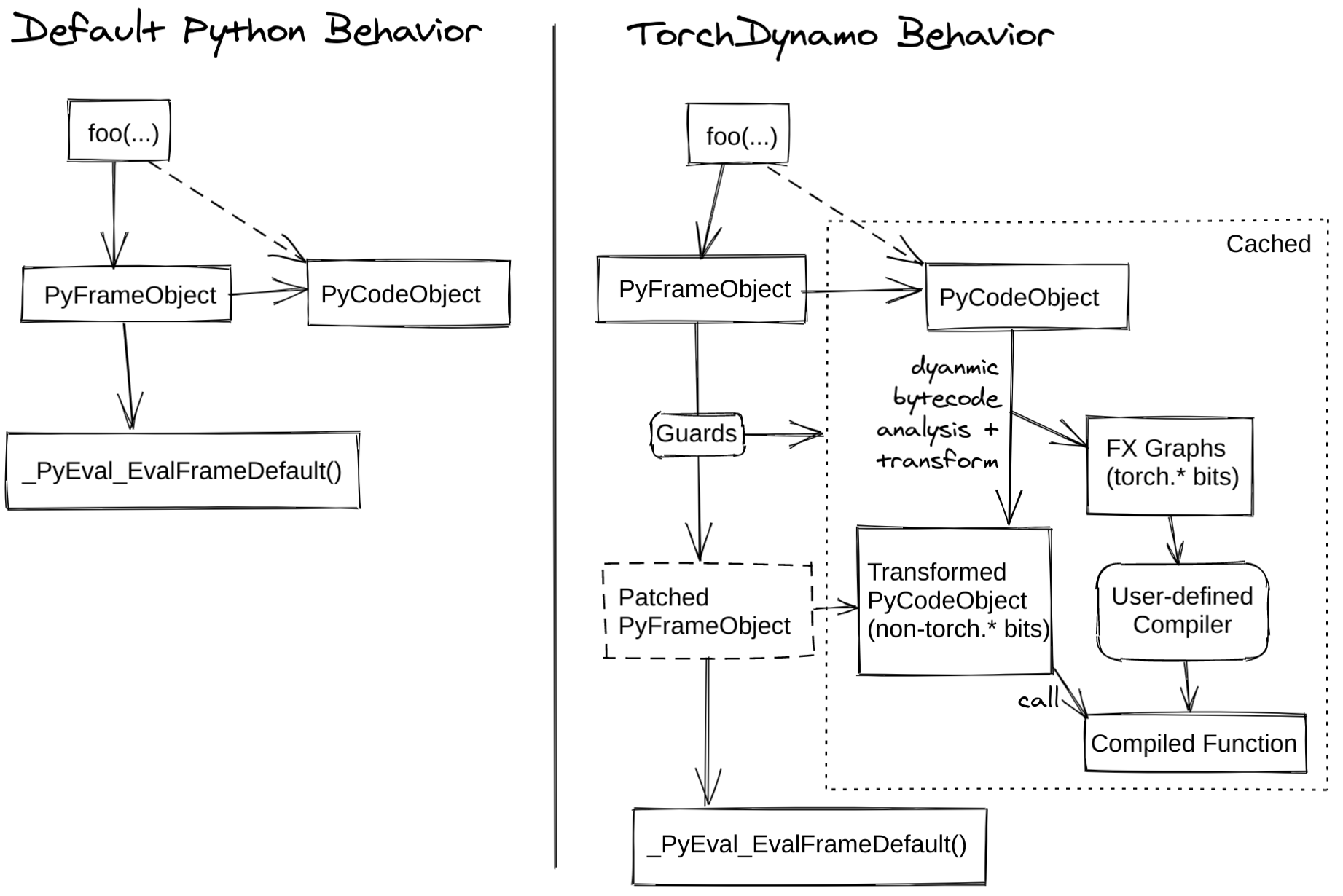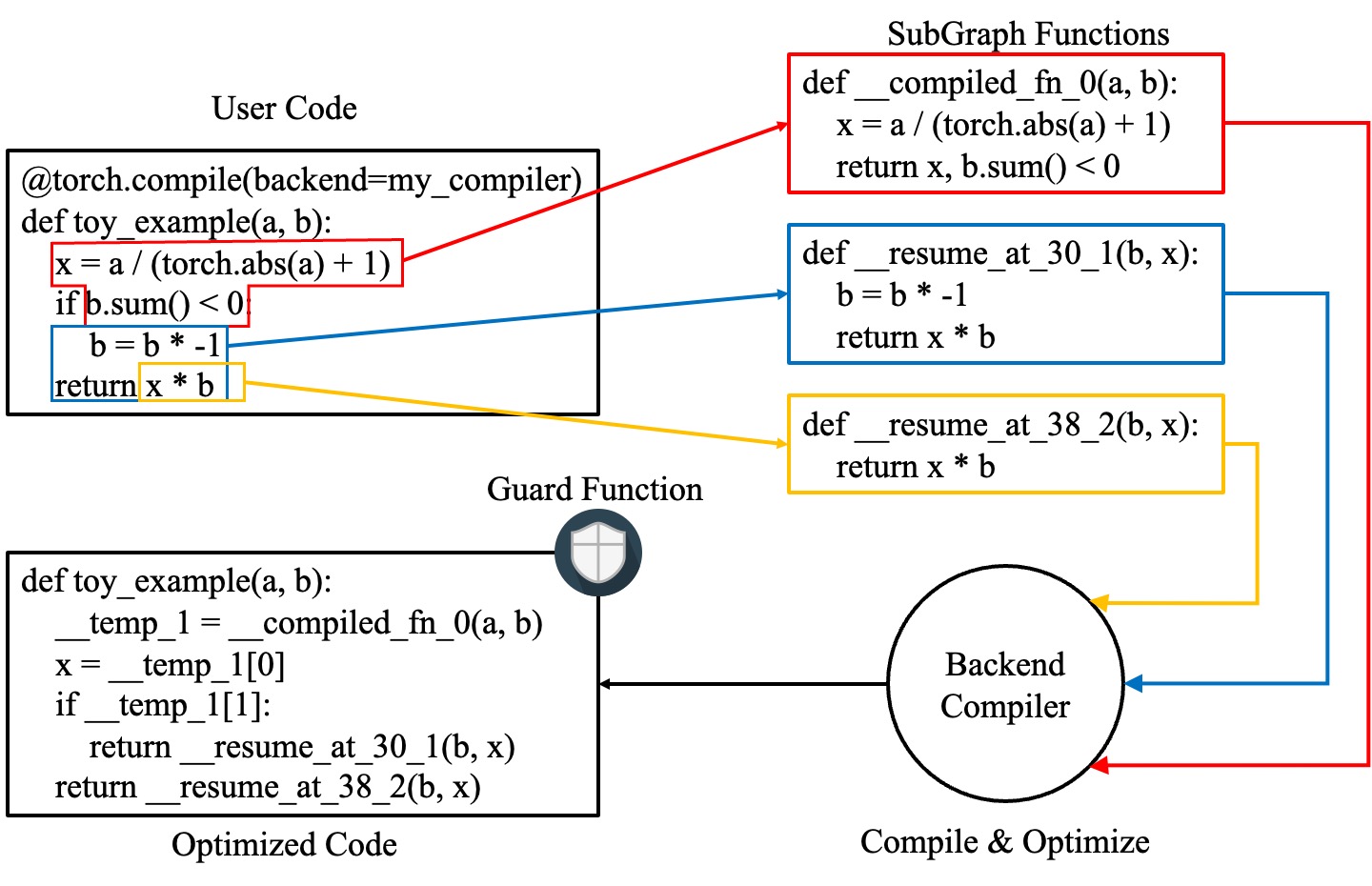TorchDynamo Deep Dive¶
Before you read this section, read torch.compiler.
TorchDynamo is a Python-level Just-In-Time (JIT) compiler designed to make unmodified PyTorch programs faster. TorchDynamo hooks into the frame evaluation API in CPython (PEP 523) to dynamically modify Python bytecode right before it is executed. It rewrites Python bytecode to extract sequences of PyTorch operations into an FX Graph which is then compiled with a customizable backend. It creates this FX Graph through bytecode analysis and is designed to mix Python execution with compiled backends to get the best of both worlds — usability and performance.
TorchDynamo makes it easy to experiment with different compiler
backends to make PyTorch code faster with a single line decorator
torch._dynamo.optimize() which is wrapped for convenience by torch.compile()
The following diagram demonstrates how PyTorch works with torch.compile
and without it:

TorchInductor is one of the backends supported by TorchDynamo Graph into Triton for GPUs or C++/OpenMP for CPUs. We have a training performance dashboard that provides performance comparison for different training backends. You can read more in the TorchInductor post on PyTorch dev-discuss.
For an in-depth overview, read the sections below, watch the deep-dive video, and check out the dev-discuss topics.
TorchDynamo Internals¶
Author: Jason Ansel and Kaichao You
This section will go over some of the TorchDynamo internals and will demonstrate how TorchDynamo works under the hood.
What is a guard?¶
TorchDynamo operates just-in-time and specializes graphs based on
dynamic properties. Below is a basic example of how to use TorchDynamo.
One can decorate a function or a method using torchdynamo.optimize to enable
TorchDynamo optimization:
from typing import List
import torch
from torch import _dynamo as torchdynamo
def my_compiler(gm: torch.fx.GraphModule, example_inputs: List[torch.Tensor]):
print("my_compiler() called with FX graph:")
gm.graph.print_tabular()
return gm.forward # return a python callable
@torchdynamo.optimize(my_compiler)
def toy_example(a, b):
x = a / (torch.abs(a) + 1)
if b.sum() < 0:
b = b * -1
return x * b
for _ in range(100):
toy_example(torch.randn(10), torch.randn(10))
For example, the first graph above has the following guards:
GUARDS:
- local 'a' TENSOR_MATCH
- local 'b' TENSOR_MATCH
- global 'torch' FUNCTION_MATCH
If any of those guards fail, the graph will be recaptured and
recompiled. The interesting guard type there is TENSOR_MATCH, which
checks the following torch.Tensor properties:
Python class of the tensor (tensor subclassing, etc)
dtype
device
requires_grad
dispatch_key (with thread-local includes/excludes applied)
ndim
sizes*
strides*
The full specialization mode allows the backend compiler to assume an entirely static graph. Unfortunately, most backends require this. Operators which return dynamic shapes will trigger a graph break when not in dynamic shape mode.
What is Dynamo doing?¶
If you want to understand better what TorchDynamo is doing, you can run your code with:
TORCH_LOGS="+dynamo,guards,bytecode"
This code triggers useful (but spammy) printouts.
For example, the printouts for the first graph in the toy_example
are:
__compiled_fn_0 <eval_with_key>.1
opcode name target args kwargs
------------- ------- ------------------------------------------------------ ---------------- --------
placeholder a a () {}
placeholder b b () {}
call_function abs_1 <built-in method abs of type object at 0x7f9ca082f8a0> (a,) {}
call_function add <built-in function add> (abs_1, 1) {}
call_function truediv <built-in function truediv> (a, add) {}
call_method sum_1 sum (b,) {}
call_function lt <built-in function lt> (sum_1, 0) {}
output output output ((truediv, lt),) {}
ORIGINAL BYTECODE toy_example example.py 9
10 0 LOAD_FAST 0 (a)
2 LOAD_GLOBAL 0 (torch)
4 LOAD_METHOD 1 (abs)
6 LOAD_FAST 0 (a)
8 CALL_METHOD 1
10 LOAD_CONST 1 (1)
12 BINARY_ADD
14 BINARY_TRUE_DIVIDE
16 STORE_FAST 2 (x)
11 18 LOAD_FAST 1 (b)
20 LOAD_METHOD 2 (sum)
22 CALL_METHOD 0
24 LOAD_CONST 2 (0)
26 COMPARE_OP 0 (<)
28 POP_JUMP_IF_FALSE 38
12 30 LOAD_FAST 1 (b)
32 LOAD_CONST 3 (-1)
34 BINARY_MULTIPLY
36 STORE_FAST 1 (b)
13 >> 38 LOAD_FAST 2 (x)
40 LOAD_FAST 1 (b)
42 BINARY_MULTIPLY
44 RETURN_VALUE
MODIFIED BYTECODE
9 0 LOAD_GLOBAL 3 (__compiled_fn_0)
2 LOAD_FAST 0 (a)
4 LOAD_FAST 1 (b)
6 CALL_FUNCTION 2
8 UNPACK_SEQUENCE 2
10 STORE_FAST 2 (x)
12 POP_JUMP_IF_FALSE 24
14 LOAD_GLOBAL 4 (__resume_at_30_1)
16 LOAD_FAST 1 (b)
18 LOAD_FAST 2 (x)
20 CALL_FUNCTION 2
22 RETURN_VALUE
>> 24 LOAD_GLOBAL 5 (__resume_at_38_2)
26 LOAD_FAST 1 (b)
28 LOAD_FAST 2 (x)
30 CALL_FUNCTION 2
32 RETURN_VALUE
GUARDS:
- local 'a' TENSOR_MATCH
- local 'b' TENSOR_MATCH
- global 'torch' FUNCTION_MATCH
At the top you can see the FX graph. Next, you see the original bytecode of the function, followed by the modified bytecode generated by TorchDynamo. Finally, you see the guards which we covered above.
In the modified bytecode, __compiled_fn_0 is the return value of
my_compiler() (the compiled graph). __resume_at_30_1 and
__resume_at_38_2 are both generated continuation functions that pick
up execution after a graph break (at bytecode offsets 30 and 38). Each
of these functions take the form:
__resume_at_<offset>:
... restore stack state if needed ...
JUMP_ABSOLUTE <offset> into toy_example
... original bytecode of toy_example ...
By generating this resume_at function, we force the remainder of the function to be executed in a new Python frame which recursively triggers TorchDynamo to restart its capture once execution reaches that point for the first time.
How to inspect artifacts generated by TorchDynamo?¶
To inspect the artifacts generated by TorchDynamo, there is an API torch._dynamo.eval_frame._debug_get_cache_entry_list that retrieves compiled code and guards out of a function’s __code__ object. A compiled function can have several cache entries, and each cache entry consists a generated function to check guards, and a types.CodeType object to keep the code to be executed if the guarding conditions are satisfied.
from torch._dynamo.eval_frame import _debug_get_cache_entry_list
cache_entries = _debug_get_cache_entry_list(toy_example._torchdynamo_orig_callable)
cache_entry = cache_entries[0]
guard, code = cache_entry.check_fn, cache_entry.code
# the guard takes the local variables of an input frame, and tells whether a re-compilation should be triggered.
import dis
dis.dis(guard)
dis.dis(code)
If you know Python bytecode, you can understand the above output. There is also a tool depyf to convert the bytecode into human-readable source code. If you don’t have depyf already installed, run pip install depyf before running the code below.
from depyf import decompile
print("guard code:")
print(decompile(guard))
print("compiled code:")
print(decompile(code))
The output is:
guard code:
def guard(L):
if not getattr(___guarded_code, 'valid'):
return False
_var0 = L['a']
if not hasattr(_var0, '_dynamo_dynamic_indices') == False:
return False
_var1 = L['b']
if not hasattr(_var1, '_dynamo_dynamic_indices') == False:
return False
if not ___is_grad_enabled():
return False
if ___are_deterministic_algorithms_enabled():
return False
if not ___is_torch_function_enabled():
return False
if not getattr(utils_device, 'CURRENT_DEVICE') == None:
return False
if not ___check_tensors(_var0, _var1, tensor_check_names=tensor_check_names
):
return False
return True
compiled code:
def toy_example(a, b):
__temp_1 = __compiled_fn_0(a, b)
x = __temp_1[0]
if __temp_1[1]:
return __resume_at_30_1(b, x)
return __resume_at_38_2(b, x)
Some names referenced in the code are:
Compiled functions, stored in the global namespace of the module containing the original function
toy_example. These include names like__compiled_fn_0/__resume_at_30_1/__resume_at_38_2.Closure variables used for checking guards. The names can be accessed from
guard.__code__.co_freevars, and the values are stored inguard.__closure__. These include names like___guarded_code/___is_grad_enabled/___are_deterministic_algorithms_enabled/___is_torch_function_enabled/utils_device/___check_tensors/tensor_check_names.Argument
Lof theguardfunction. This is a dict mapping the name of arguments oftoy_exampleto its values. This is only available when the function is called, where the frame evaluation API comes into play. In short,Lis adictwith structure of{'a': value_a, 'b': value_b}. Therefore, you can see the code usesL['a']to refer to the input variablea.
The graph break is shown in the code of compiled toy_example, where we have to use Python interpreter to select the following graph to execute.
Note that we pass a simple my_compiler function as the backend compiler, therefore the subgraph code __resume_at_38_2, __resume_at_30_1, and __compiled_fn_0 remain Python code. This can also be inspected (please ignore the function name, and only use the function signature and function body code):
print("source code of __compiled_fn_0:")
print(__compiled_fn_0._torchdynamo_orig_callable.__self__)
print("=" * 60)
print("source code of __resume_at_30_1:")
print(decompile(__resume_at_30_1))
print("=" * 60)
print("source code of __resume_at_38_2:")
print(decompile(__resume_at_38_2))
source code of __compiled_fn_0:
GraphModule()
def forward(self, L_a_ : torch.Tensor, L_b_ : torch.Tensor):
l_a_ = L_a_
l_b_ = L_b_
abs_1 = torch.abs(l_a_)
add = abs_1 + 1; abs_1 = None
truediv = l_a_ / add; l_a_ = add = None
sum_1 = l_b_.sum(); l_b_ = None
lt = sum_1 < 0; sum_1 = None
return (truediv, lt)
# To see more debug info, please use ``graph_module.print_readable()``
============================================================
source code of __resume_at_30_1:
def <resume in toy_example>(b, x):
b = b * -1
return x * b
============================================================
source code of __resume_at_38_2:
def <resume in toy_example>(b, x):
return x * b
However, if we use other backends like the built-in inductor, the subgraph code will be compiled CUDA kernels for GPU or C++ code for CPU.
To summarize, the compiled code is conceptually equivalent to the code below:
def compiled_example(a, b):
L = {'a': a, 'b': b}
for guard, code in get_cache_entries():
if guard(L):
return code(a, b)
recompile_and_add_another_cache_entry()
The following diagram demonstrates how torch.compile transforms and optimizes user-written code: it first extracts computation graphs from the user-written function, and compiles these graphs into optimized functions, then assembles them into a new function, which is functionally equivalent to the user-written code but optimized to have a good computation speed.

